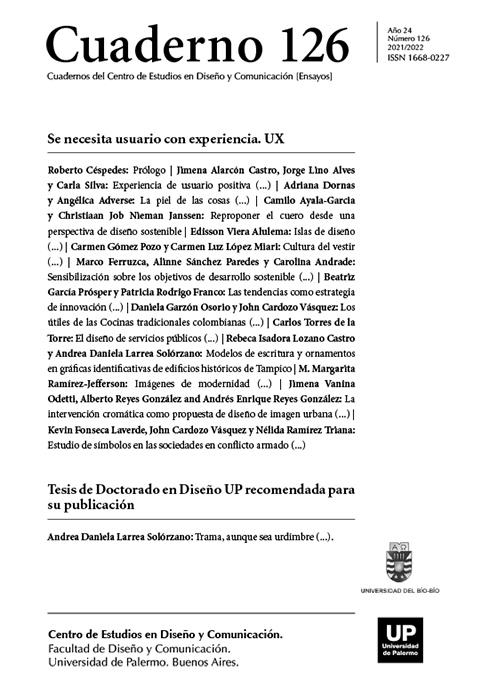La intervención cromática como propuesta de diseño de imagen urbana para áreas periurbanas, el caso del Coapinole, Puerto Vallarta, Jalisco, Méxic
Abstract
The present work suggests the chromatic intervention, as a proposal for the design and improvement of the urban image in Peri-urban areas, taking as a case study the El Coapinole neighborhood in the city of Puerto Vallarta, Jalisco, Mexico. It is proposed to conceive color as an element of intervention to trigger the development of Peri-urban areas of the city. At the same time, color is considered as an articulating element of the urban fabric with the surrounding neighborhoods, in a city with tourist characteristics and with unequal degrees of development. For the chromatic intervention, a qualitative research and action research methodology is proposed that considers color as an integrated element in the study of the urban image and the infrastructure of the peri-urban areas selected as a case study. The starting point was an integral diagnosis, to identify and select the areas to intervene, to involve the community with the participation of the stakeholders, to formulate an intervention proposal based on the existing contextual development. The proposal of a chromatic intervention as part of the improvement of the urban image design in these contexts of edges of city, means that it constitutes, not only the visual memory of an urban area, but the living image of the city, the experiences of its inhabitants and how they interact together with the colors, in their streets, their squares, their constructions, the natural context, their facades and their textures. It is emphasized here how all these elements, highlighting color, play a preponderant role in the configuration of the identity of a space or a certain area, and in the urban cultural construction of it. The results, coming from the study and chromatic intervention, show the necessity in the border areas of the city to generate improvements for the inhabitants and for the users as products of a joint action, established between the University and the different social actors that participate in the community.
References
Bengoa, G. (2001). “Evolución histórica del periurbano marplatense”. En Donde muere la ciudad, pp. 21-48, Héctor Echechuri, (compilador). Mar del Plata: Centro de Investigaciones Ambientales, FAUD, UNMdP. Inédito.
Ferraro, R.; Zulaica, L. & Echechuri, H. (2013). Perspectivas de abordaje y caracterización del periurbano de Mar del Plata, Argentina.
Lenclos, J. P. & Lenclos, D. (1999). Colors of the world. New York: Norton.
Morello, J. (2000). Funciones del sistema periurbano, el caso de Buenos Aires. Texto correspondiente a materia de la Maestría en Gestión Ambiental del Desarrollo Urbano. Mar del Plata: Centro de Investigaciones Ambientales, FAUD-UNMdP.
Odetti, J. V. (14 de Marzo de 2019). Los colores de Puerto Vallarta, en la construcción cultural urbana de una ciudad turística. 1990 - 2016. Buenos Aires, Argentina: Universidad de Palermo.
Odetti, J. V.; Reyes González, A. & Reyes González, A. E. (2019). The chromatic intervention as a proposal of urban image design for university contexts: the case of Coapinole,
Puerto Vallarta. En A. I. Association, Proceedings of the International Colour Association (AIC) (págs. 454-460). Newtown, NSW, Australia: AIC International Colour Association.
Pérez Campusano, E. (2010). Segregación socioespacial en ciudades turísticas, el caso de
Puerto Vallarta, México. Región y sociedad 22(49), 143-176.
Signorelli, A. (1999). Antropología Urbana. México: Anthropos Editorial.
Wirth, L. (2011). Leer la ciudad. Ensayos de antropología urbana. El urbanismo como forma de vida. Revista de estudios sociales, 110-115.
Zybaczynski, V. (2016). [Colour Studies] Re:Placing Colours. Evaluation of the Chromatic Interventions on the Blocks of Flats in Bucharest, Romania. Book of proceedings- AIC2016 Interim Meeting Color in Urban Life: Images, Objects and spaces (págs. 39-43). Santiago de Chile: Asociación Chilena del Color.
Los autores/as que publiquen en esta revista ceden los derechos de autor y de publicación a "Cuadernos del Centro de Estudios de Diseño y Comunicación", Aceptando el registro de su trabajo bajo una licencia de atribución de Creative Commons, que permite a terceros utilizar lo publicado siempre que de el crédito pertinente a los autores y a esta revista.


